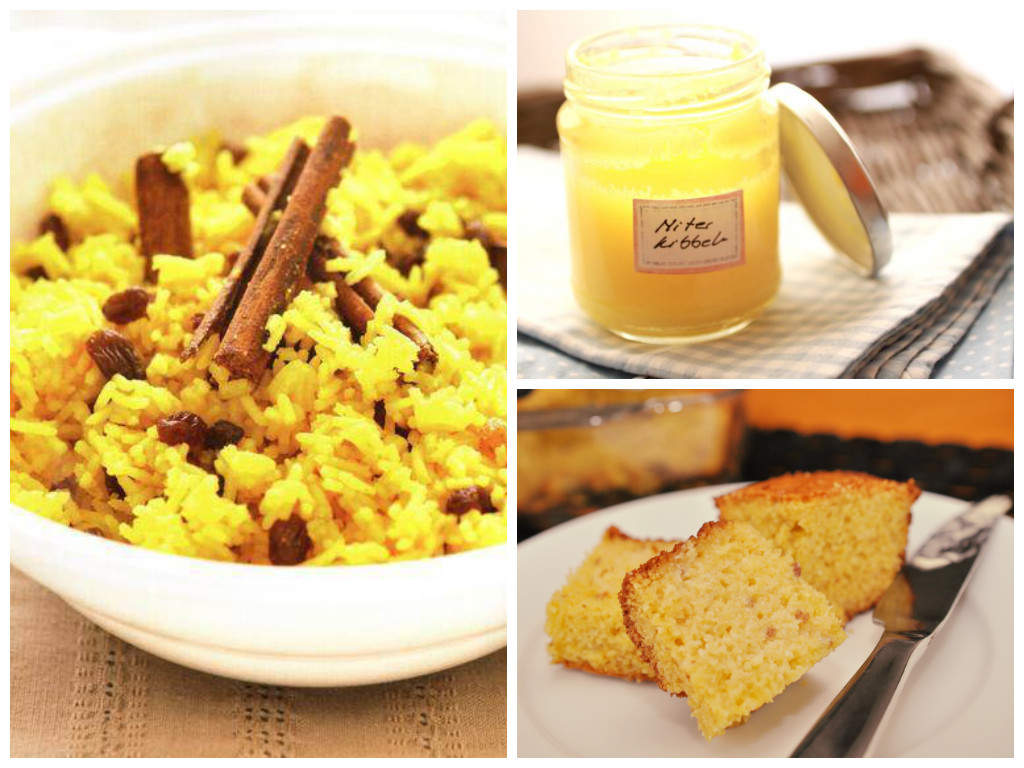In most American communities, casseroles and deli platters — often brought over by sympathetic friends and neighbors — are standard-issue post-funeral fare. But around the world, mourners are fed a wide range of flavorful dishes, explains writer Lisa Rogak in her book “Death Warmed Over: Funeral Food Rituals, and Customs from Around the World” (Ten Speed Press). From Mexican Bread of the Dead to South African Funeral Rice to Swedish Funeral Glogg, find out how the rest of the world mourns with food and drink. These recipes, and information about their significance, are reprinted with permission from “Death Warmed Over,” which is newly available as an ebook.
KOLIVA (Greece)
Ingredients:
1 cup wheat berries
4 quarts water
1 cup raisins
1 cup chopped walnuts
½ cup honey
1 teaspoon cinnamon
¼ cup confectioners’ sugar
1/3 cup Jordan almonds
Instructions:
In a large stockpot, stir the wheat berries into the water. Bring to a boil, decrease the heat and simmer over a low flame, stirring occasionally, for about 2 hours, until tender.
Drain the wheat in a colander and spread it onto a large towel for about a minute to absorb the remaining water.
Put the wheat in a large mixing bowl and add the raisins, walnuts, honey and cinnamon. Mix well. Let cool.
When cool, pour the mixture out on to a large serving platter and shape into a mound. Sift the sugar over the top, covering evenly.
Top off with Jordan almonds
Significance:
“Some Greeks believed that the only way to ensure that the gods would forgive the sins of the deceased was for the surviving relatives and friends to eat plenty [of koliva] at the funeral,” Rogak writes.
PAN DE MUERTO/ BREAD OF THE DEAD (Mexico)
Ingredients:
½ cup (1 stick) unsalted butter
½ cup milk
½ cup water
5 to 5 ½ cups all-purpose flour
2 packages dry yeast
1 teaspoon salt
1 tablespoon whole anise seed
1 cup sugar
4 eggs
1/3 cup freshly squeezed orange juice
2 tablespoon grated orange zest
Instructions:
In a saucepan over a medium flame, heat the butter, milk and water until the butter is melted.
In a large mixing bowl, combine 1½ cup of the flour, the yeast, salt and anise seed and ½ cup of the sugar. Add the butter and milk mixture and stir until well combined. Add the eggs and heat in another cup of flour. Continue to add more flour until the dough is soft but not sticky. Knead the dough on a lightly floured board for 10 minutes, or until smooth and elastic.
Lightly grease a large mixing bowl and place the dough in it. Cover with plastic wrap and let rise in a warm place until doubled in bulk, about 1½ hours. Punch the dough down and shape into 2 loaves resembling skulls or skeletons. Let rise in a warm place for 1 hour.
Preheat the oven to 350 F. Bake the loaves on a baking sheet for 40 minutes or until the tops are golden brown. While the bread is baking, prepare the glaze. In a small saucepan, mix the remaining ½ cup sugar and the orange juice and zest over high heat. Bring to a boil, stirring constantly for two minutes, then remove from the heat. Keep warm. When the bread is done, apply the glaze to the hot loaves with a pastry brush.
Makes 2 loaves
Significance: “Food is also a central part of Day of the Dead [November 1–2] celebrations for those still walking the earth,” Rogak writes. “Special black plates and bowls are sold only during the last two weeks in October, and bakeries make hundreds of life-size skull-shaped cakes with the name of the deceased written in frosting on the forehead.”
FUNERAL GLOGG (Sweden)
Ingredients:
2 quarts dry red wine
2 quarts muscatel
1 pint sweet vermouth
2 tablespoons angostura bitters
2 cups raisins
Grated peel of one orange
12 cardamom pods, crushed
10 whole cloves
1 two-inch piece of fresh ginger, peeled
1 cinnamon stick
1 ½ cups aquavit
1 ½ cups sugar
2 cups blanched slivered almonds
In a large pot, combine the wine, muscatel, vermouth, bitters, raisins, orange peel, cardamom, cloves, ginger and cinnamon. Cover and let stand at room temperature for at least 12 hours.
Just before serving, add the aquavit and sugar. Place over high heat, stir and bring to a boil. Remove from the heat, add the almonds and serve.
Serves 25
Significance:
“Unlike funeral feasts in other countries — which can get downright bawdy— in Sweden, post-funeral socializing focuses primarily on the dead, with everyone offering multiple toasts to the memory of the deceased,” writes Rogak.
FUNERAL RICE (South Africa)
Ingredients:
1 tablespoon sugar
½ teaspoon turmeric
1 tablespoon salt
2 tablespoons unsalted butter
1 cinnamon stick
1 1-inch strip lemon peel
1 cup uncooked white rice
1 cup raisins
Instructions:
In a large pot, bring 6 cups of water to a boil. Add the sugar, turmeric, salt, butter, cinnamon stick and lemon peel. Stir until the sugar is dissolved. Decrease the heat, add the rice and cover. Simmer for 10 minutes, then stir in the raisins. Cover and cook for an additional 10 minutes or until the rice is cooked. Remove the cinnamon stick and lemon peel before serving
Serves 6
Significance:“One of the oldest rice dishes in South Africa is begranisrys, or funeral rice,” writes Rogak.
NORWEGIAN FUNERAL CAKE (Norway)
Ingredients:
1½ cups (3 sticks) unsalted butter, at room temperature
2 cups granulated sugar
3 eggs
1½ cups sour cream
2 teaspoons vanilla extract
3 cups all purpose flour
2 ¼ teaspoons vanilla extract
3 cups all-purpose flour
2¼ teaspoons baking powder
¾ teaspoon baking soda
3/8 teaspoon salt
1 cup heavy cream
¼ cup plus 1 tablespoon brown sugar
½ cup chopped walnuts
½ cup walnuts halves
Instructions:
Preheat the oven to 350F. Grease and flour three 9-inch round cake pans. With an electric mixer or by hand, cream the butter and sugar together in a large bowl. Beat in the eggs, one at a time, until the mixture is fluffy. Add the sour cream and 1½ teaspoons of the vanilla and stir well. In a separate bowl, sift the flour, baking powder, baking soda and salt together. Add to the creamed mixture and mix thoroughly.
Pour the batter into the prepared pans . Bake for 45 minutes or until a tester comes out clean. Allow the layers to rest for 15 minutes in the pans then turn out onto a rack to cool.
When the layers are completely cool, whip the cream with the ¼ cup brown sugar and the remaining ½ teaspoon vanilla. To assemble, place one layer on a platter, spread with one-third of the whipped cream and sprinkle with one-third of the chopped walnuts. Repeat with the other two layers. Sift the 1 tablespoon brown sugar over the top, and decorate with the walnut halves. If you like, you can use them to spell out the name [or initials] of the deceased.
Significance:
“One old Norwegian custom calls for guests to make a frosted cake, inscribe the initials of the deceased person into the frosting and carry the cake in a wooden basket to the funeral,” Rogak writes. “After, each guest gives their cake to the surviving head of family, who sits at the door.”
JOHNNYCAKE (Jamaica)
Ingredients:
1 cup yellow cornmeal
1½ cups milk
½ cup butter, at room temperature
½ cup sugar
1 1/3 cups pastry flour
2 ½ teaspoons baking powder
1 teaspoon salt
1 egg
Instructions:
Preheat the oven to 350F Grease an 8-inch square pan. In a large mixing bowl, combine the cornmeal and ½ cup of the milk. Set aside.
In another bowl, cream the butter and gradually add the sugar. Set aside.
In another bowl, sift the flour, baking powder and salt together. In a glass measuring cup, beat together the egg and the remaining 1 cup milk. Alternately add the flour mixture and the milk/egg mixture to the butter mixture, stirring after each addition until combined. Add the cornmeal mixture and mix until smooth.
Pour into the prepared pan and bake for 45 minutes. Cut into nine squares and serve hot with butter and syrup, if desired.
Makes 9 squares
Significance:
“Some Jamaicans also place several johnnycakes — the original term was journey cake — in the casket with the deceased just before burial to make sure that the soul has enough food for the journey,” according to Rogak.
SPICED BUTTER/NITER KEBBEH (Ethiopia)
Ingredients:
2 pounds (8 sticks) unsalted butter, cut into small pieces
1 onion coarsely chopped
3 tablespoons minced garlic
2 tablespoons minced fresh ginger
1 teaspoon ground turmeric
1 teaspoon ground cardamom
1 cinnamon stick
1 whole clove
¼ teaspoon ground nutmeg
Ingjera (Ethiopian flatbread) or other flatbread
Instructions:
In a large saucepan, melt the butter slowly over medium-low heat. When it is completely melted, increase the heat to high and add the onion, garlic, ginger, turmeric, cardamom, cinnamon, clove and nutmeg. Stir to blend. Decrease the heat to low and simmer uncovered for 45 minutes. Do not stir. The milk solids on the bottom of the pan should be golden brown, and the butter on top should be clear.
Slowly pour the clear liquid into a bowl, straining through cheesecloth. It is important no solids are left in the niter kebbeh. Transfer the liquid into a jar. Cover tightly and store in the refrigerator up to one week. Serve spread on flatbread
Makes 2 cups
Significance:
“The official sign that the mourning period is over is when the widow rubs butter into her hair,” Rogak writes.
Lisa Rogak is a New York Times bestselling author. Additional funeral recipes can be found in “Death Warmed Over.”









